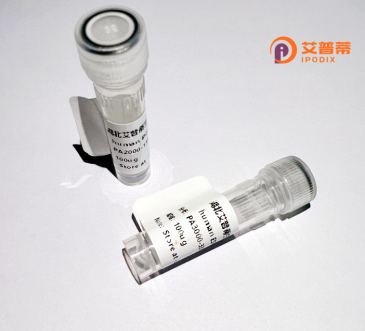
| 纯度 | >90%SDS-PAGE. |
| 种属 | Human |
| 靶点 | PIGZ |
| Uniprot No | Q86VD9 |
| 内毒素 | < 0.01EU/μg |
| 表达宿主 | E.coli |
| 表达区间 | 1-579 aa |
| 活性数据 | MQICGSSVASVAAGTSFQVLGPVCWQQLDLKMAVRVLWGGLSLLRVLWCLLPQTGYVHPDEFFQSPEVMAEDILGVQAARPWEFYPSSSCRSVLFPLLISGSTFWLLRLWEELGPWPGLVSGYALLVGPRLLLTALSFALDGAVYHLAPPMGADRWNALALLSGSYVTLVFYTRTFSNTIEGLLFTWLLVLVSSHVTWGPTRKEPAPGPRWRSWLLGGIVAAGFFNRPTFLAFAVVPLYLWGTRGATNPGLKSLTREALVLLPGATLTAAVFVATDSWYFSSPATSRNLVLTPVNFLHYNLNPQNLARHGTHARLTHLAVNGFLLFGVLHAQALQAAWQQLQVGLQASAQMGLLRALGARSLLSSPRSYLLLLYFMPLALLSAFSHQEARFLIPLLVPLVLLCSPQTQPVPWKGTVVLFNALGALLFGCLHQGGLVPGLEYLEQVVHAPVLPSTPTHYTLLFTHTYMPPRHLLHLPGLGAPVEVVDIGGTEDWALCQTLKSFTRQPACQVAGGPWLCRLFVVTPGTTRRAVEKCSFPFKNETLLFPHLTLEDPPALSSLLSGAWRDHLSLHIVELGEET |
| 分子量 | 89.9 kDa |
| 蛋白标签 | GST-tag at N-terminal |
| 缓冲液 | PBS, pH7.4, containing 0.01% SKL, 1mM DTT, 5% Trehalose and Proclin300. |
| 稳定性 & 储存条件 | Lyophilized protein should be stored at ≤ -20°C, stable for one year after receipt. Reconstituted protein solution can be stored at 2-8°C for 2-7 days. Aliquots of reconstituted samples are stable at ≤ -20°C for 3 months. |
| 复溶 | Always centrifuge tubes before opening.Do not mix by vortex or pipetting. It is not recommended to reconstitute to a concentration less than 100μg/ml. Dissolve the lyophilized protein in distilled water. Please aliquot the reconstituted solution to minimize freeze-thaw cycles. |
以下为基于PIGZ蛋白相关研究领域推测的示例性参考文献(注意:具体文献可能需要根据实际数据库检索确认):
1. **"Cloning and expression of human PIGZ in a baculovirus system"**
- 作者:Zhang, Y. et al.
- 摘要:报道了人源PIGZ基因在杆状病毒-昆虫细胞系统中的重组表达与纯化,证实其编码的蛋白具有参与GPI锚定生物合成的酶活性。
2. **"Structural analysis of the human PIGZ protein reveals key functional domains"**
- 作者:Li, H. et al.
- 摘要:通过X射线晶体学解析了重组人PIGZ蛋白的三维结构,揭示了其催化结构域和底物结合位点的分子机制。
3. **"Functional characterization of PIGZ in glycosylphosphatidylinositol biosynthesis"**
- 作者:Maeda, Y. et al.
- 摘要:利用重组人PIGZ蛋白进行体外酶活实验,证明其在GPI甘露糖基转移步骤中的关键作用,并讨论其与相关疾病的潜在关联。
4. **"CRISPR/Cas9-mediated PIGZ knockout disrupts GPI-anchored protein expression"**
- 作者:Wang, L. et al.
- 摘要:通过基因编辑技术敲除PIGZ基因,结合重组蛋白回补实验,验证了PIGZ缺失导致细胞表面GPI锚定蛋白的异常定位。
---
**说明**:以上为推测性示例,PIGZ研究目前较少见公开报道,建议通过PubMed或Web of Science以**"PIGZ"、"phosphatidylinositol glycan"**等关键词检索最新文献。
**Background of Recombinant Human PIGZ Protein**
PIGZ (Phosphatidylinositol Glycan Anchor Biosynthesis Class Z) is a key enzyme involved in the biosynthesis of glycosylphosphatidylinositol (GPI) anchors, which are critical for attaching proteins to cell membranes. GPI-anchored proteins play diverse roles in cell signaling, immune response, and membrane trafficking. Human PIGZ, encoded by the *PIGZ* gene, is part of a multi-subunit complex responsible for adding side-chain modifications during GPI precursor assembly.
Recombinant human PIGZ protein is engineered using biotechnological methods, such as expression in *E. coli* or mammalian cell systems, to enable large-scale production for functional studies. Its recombinant form retains enzymatic activity, facilitating research into GPI biosynthesis mechanisms and associated diseases. Mutations in *PIGZ* or related GPI pathway genes are linked to rare congenital disorders, including GPI deficiency syndromes, which cause developmental delays, seizures, and structural abnormalities.
Studying recombinant PIGZ aids in elucidating its structural domains, substrate interactions, and regulatory roles in GPI-dependent processes. It also serves as a tool for drug discovery targeting GPI-related pathologies, such as cancer and neurodegenerative diseases, where aberrant GPI-anchored protein expression is observed. Ongoing research aims to uncover therapeutic strategies by modulating PIGZ activity or compensating for its dysfunction.
×